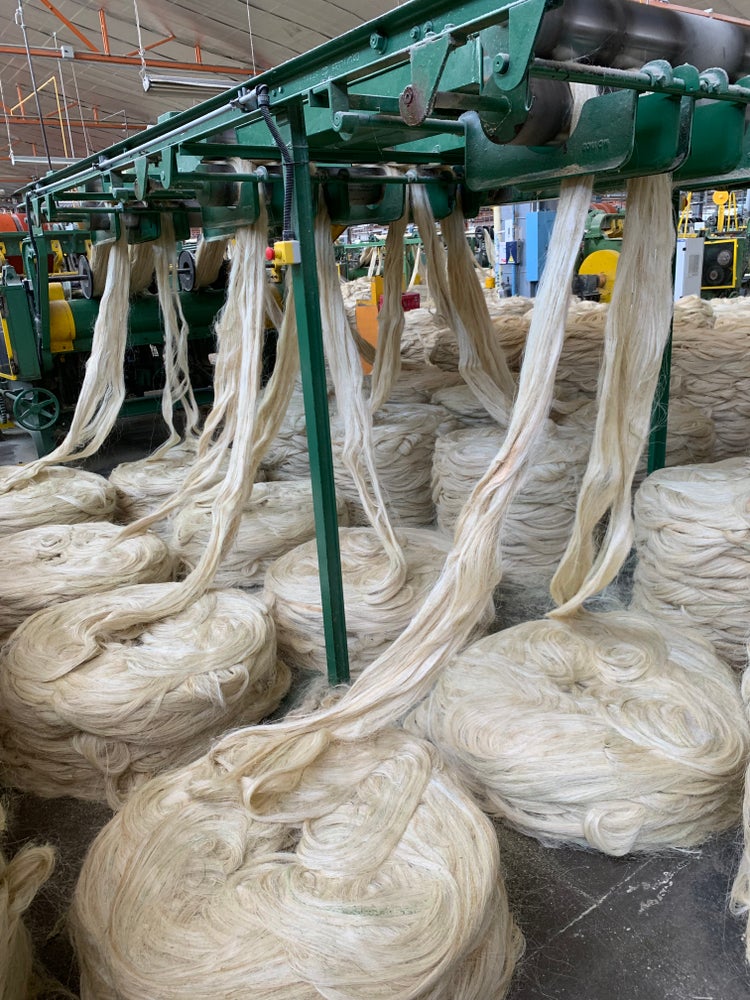From the Field, Resources for Roasters, News
Monday, January 24, 2022
Fique: Colombia’s Hidden Treasure
Fique. You may not have heard of it, but this miraculous fiber is sustainable, improves livelihoods and offers options for farmers in illicit crop-growing areas, and offers a neutral bag for packaging coffee. We spoke with experts at Excala Packaging (who produce bags for nearly half of all coffee produced in Colombia) about the history, benefits and future of fique.

This article is now available as an audio article. Check it out!
What is Fique?
The fique plant is indigenous to the Andean mountains. It is closely related to sisal and similar to agave, but with bigger leaves. The crop can be harvested year-round and long leaves are cut from the plant every 3 to 4 months. The leaves are then processed through a machine that cuts them into long, thin fibers. Fibers are hung to dry for 12 to 18 hours.
Why Fique?
Fique has positive environmental, social and coffee quality implications.
Fique plants take 3 to 4 years to bear leaves that are fit for fique processing but, once they reach that stage, fique plants can be cultivated for 30 years. Juan David Garces, VP of Marketing & Sales at Excala, explains, “Fique is much better for the environment. Because we’re not cutting the plant out completely, we’re preserving the carbon capture ability of the plant and reducing the overall carbon in the atmosphere.”
Fique processing also uses far less water than jute or sisal production. Fique is cut and air-dried, unlike jute and sisal, which are fermented in water, leading to a reduced resource footprint for fique bags compared to jute or sisal.
Socially, fique plays an important role in the livelihoods of indigenous communities in southern Colombia, where 70% of Colombia’s fique crop is grown. Families in the region where fique is grown face a difficult choice between fique, coffee and illicit crops such as coca, the plant from which cocaine is derived. “Fique is a suitable alternative to illicit crops,” explains Jaime Villegas, Excala’s Packaging Director, “Somewhere between 50,000 and 70,000 families grow fique in Cauca and Narino, instead of illicit crops.” About 22,000 tons of fique are produced each year and around three-quarters of that fique is used in coffee packaging.
Most families plant fique on the perimeter of their farms. Since fique can be harvested year-round, it functions like a savings account, Juan David Garces explains. “Whenever they need money, they go and cut leaves and harvest fique. If there’s not enough demand one month, they can wait a few months and harvest when there’s demand,” he says.
Excala aids communities with technical and economic support for fique production, including providing machinery for cutting fique leaves, agricultural extension on proper management techniques and seeds to replant old or dead fique plants.
Fique is also a good choice for packaging coffee because it has a higher resistance to avoid loss of grains during transportation and has a much more neutral smell than jute and sisal, which are fermented and have a strong smell. Especially for coffees not packaged in plastic liners, fique is a good option for minimizing external scents.
The Future of Fique
In the past, fique remained a largely Colombian crop due to higher costs of production. In the global market, fique was not as competitive price-wise as jute and sisal. Currently, logistics disruptions have increased the price of jute, as well as the price of transporting it from Asia Pacific, where it is mostly grown. As a result, fique is more competitive than ever and trying to close the gap. Currently, Excala and other fique packagers are exporting fique to Peru, Mexico and Ecuador.
Fique is a lesser-known option for packaging coffees that has major functional, environmental and social benefits. Most of our coffees from Colombia are packaged in fique. Contact your trader to learn more and book your coffees today.
This article is now available as an audio article. Check it out!